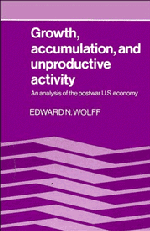Book contents
- Frontmatter
- Contents
- Preface
- 1 Introduction
- 2 Unproductive activity in a capitalist society
- 3 A Marxian accounting framework
- 4 A growth model of accumulation and unproductive labor
- 5 Rise of unproductive activity in postwar economy
- 6 Absorption of labor and capital and rate of surplus value
- 7 Absorption of new resources and growth in real income
- 8 Conclusions and speculations
- Appendix: Data sources and methods
- References
- Index
6 - Absorption of labor and capital and rate of surplus value
Published online by Cambridge University Press: 24 March 2010
- Frontmatter
- Contents
- Preface
- 1 Introduction
- 2 Unproductive activity in a capitalist society
- 3 A Marxian accounting framework
- 4 A growth model of accumulation and unproductive labor
- 5 Rise of unproductive activity in postwar economy
- 6 Absorption of labor and capital and rate of surplus value
- 7 Absorption of new resources and growth in real income
- 8 Conclusions and speculations
- Appendix: Data sources and methods
- References
- Index
Summary
Federal officials charged today that a group mostly made up of police officers, firefighters and private security guards set the string of fires three years ago that brought Boston the nationally reported title of “arson capital of the world.”
The fires were set, according to United States Attorney William Weld, to scare the public into supporting more positions for the Police and Fire Departments after property tax reductions had reduced their ranks. …
The indictment alleges that beginning sometime after July 1981, as the effect of a statewide tax-cutting measure forced layoffs of many police officers and firefighters in Massachusetts, the members of the group set 163 fires in Boston and nine surrounding cities and towns. The outlying fires were set to divert investigators away from Boston, the indictment said.
It also said that defendants who worked for a security company burned a client's building to distract attention from themselves.
The buildings burned included houses, churches, factories, restaurants, a Marine Corps barracks and the Massachusetts Fire Academy. A total of 281 firefighters were injured in the fires.
The fires listed in the indictment grew in frequency and number over the months. They stirred deep public apprehension here, generated local and national news accounts, and two years ago resulted in the Federal investigations that produced the indictments.
The indictments and arrests were announced by an assembly of Federal and state officials that included the District Attorneys of five counties, officials of the Federal Bureau of Investigation and Stephen E. Higgins, director of the Federal Bureau of Alcohol, Tobacco and Firearms.
- Type
- Chapter
- Information
- Growth, Accumulation, and Unproductive ActivityAn Analysis of the Postwar US Economy, pp. 121 - 140Publisher: Cambridge University PressPrint publication year: 1986



